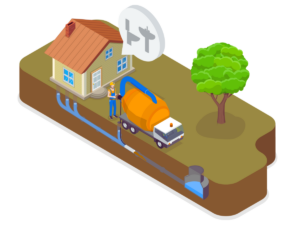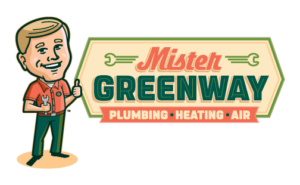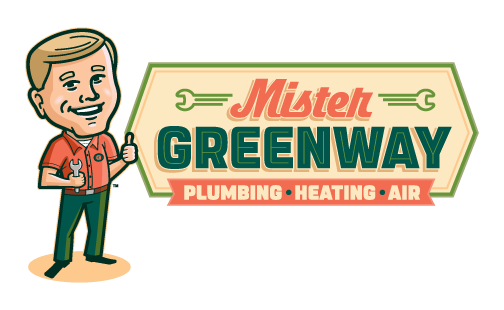 A sewer lateral is a pipe that connects a home’s plumbing to the public sewer system. It carries wastewater from sinks, toilets, and drains to the city’s sewer main.
A sewer lateral is a pipe that connects a home’s plumbing to the public sewer system. It carries wastewater from sinks, toilets, and drains to the city’s sewer main.
Homeowners rely on sewer laterals to keep wastewater moving safely away from their property. When a lateral fails, backups, foul odors, and costly repairs follow. Routine maintenance, including video inspections, helps prevent problems before they become disasters.
This guide covers everything you need to know about sewer laterals, including common issues, maintenance tips, and who’s responsible for repairs.
Key Takeaways
- A sewer lateral connects a home’s plumbing system to the public sewer.
- These pipes can be made of PVC, cast iron, or clay, with PVC being the most durable.
- Tree roots, aging pipes, and blockages are common problems.
- Property owners are responsible for the sewer line up to the property line.
- Routine inspections and maintenance prevent costly repairs.
What Is a Sewer Lateral?
 A sewer lateral is the underground pipe that links a home’s plumbing system to the city’s main sewer. It collects wastewater from smaller branch lines and transports it to the public sewer.
A sewer lateral is the underground pipe that links a home’s plumbing system to the city’s main sewer. It collects wastewater from smaller branch lines and transports it to the public sewer.
Also known as the main drain, main line, or sewer pipe, the lateral plays a critical role in home plumbing. If it clogs or breaks, waste has nowhere to go.
Structure & Types of Sewer Laterals
Sewer laterals typically have a 4-inch diameter, though some are 3 or 6 inches wide. The depth of installation varies but is usually at least 12 inches below the water line.
Common materials used for these systems are:
- PVC (Polyvinyl Chloride): The modern standard—strong, durable, and watertight.
- Cast Iron: Found in older homes, but prone to rust and clogs.
- Clay Pipes: Long-lasting but fragile. Susceptible to tree root infiltration.
Since the 1970s, PVC has replaced older materials because it resists corrosion and root damage.
Common Issues with Sewer Laterals
Even the best sewer lateral isn’t immune to problems.
Here are the most common issues:
- Tree Root Intrusion: Roots penetrate small cracks in the pipe, growing inside and causing blockages. Hydro-jetting helps remove them.
- Aging Pipes: Cast iron rusts over time, and clay pipes shift or break. Older pipes need replacement.
- Blockages from Non-Flushable Items: Grease, wipes, and feminine hygiene products clog pipes. Even “flushable” wipes don’t break down properly.
Who Is Responsible for the Sewer Lateral?
Homeowners are responsible for maintaining and repairing the lateral up to the property line. The city or municipality maintains the sewer main and any portion of the lateral within public jurisdiction. Some cities may handle repairs within the right-of-way, but policies vary.
Check with your local authorities to determine responsibility in your area.
Locating Your Sewer Lateral
 Not sure where your lateral is?
Not sure where your lateral is?
Here’s how to find it:
- In Your House: Look for a basement cleanout or floor drain.
- In Your Yard: A sewer lateral often runs in a straight line from the house to the street. A visible cleanout pipe may indicate its location.
- Access Points: Some homes have an interior cleanout, an exterior cleanout, or both.
How to Maintain Your Sewer Lateral
Regular maintenance extends the life of your sewer and prevents costly repairs.
Follow these best practices:
- Schedule video inspections every 5–10 years to check for damage.
- Avoid flushing grease, wipes, and other debris that can cause blockages.
- Dispose of fats, cooking oils, and grease (FOG) properly—not down the drain.
- Use water efficiently to reduce stress on the sewer system.
Signs You Need a Sewer Lateral Inspection
If you notice these signs, schedule a video inspection:
- Sewer backups.
- Low water levels in toilets.
- Unusual noises from drains.
- Foul odors from sinks or drains.
- Slow drains or recurring clogs.
- Drainage issues during wet weather.
- Overgrown, lush patches in your lawn (could indicate a leaking pipe).
An inspection helps determine if repairs or replacements are needed.
Protect Your Home’s Plumbing With Mister Greenway
 A damaged sewer lateral leads to expensive repairs and property damage. Stay ahead of problems with regular inspections.
A damaged sewer lateral leads to expensive repairs and property damage. Stay ahead of problems with regular inspections.
If you’re in Nashville, TN, or the surrounding area, contact Mister Greenway for professional video inspection services.
We’ll send the cavalry.
FAQs
What’s the difference between a sewer lateral and a sewer main?
A sewer lateral connects a home’s plumbing to the sewer main, which is the city’s larger underground pipe carrying wastewater to a treatment facility.
How deep is a sewer lateral buried?
It varies but is typically at least 12 inches below the water line. Depth depends on location and climate.
Who pays for sewer lateral repairs?
Homeowners are responsible for the portion of the lateral on their property. The city handles repairs on the public side.
How often should I get a sewer lateral inspection?
Every 5–10 years, or immediately if you notice signs of trouble.
Can tree roots damage my sewer lateral?
Yes. Tree roots seek moisture and can enter cracks in pipes, leading to blockages and damage.
Final Thoughts
Your sewer lateral is essential for moving wastewater safely from your home to the public sewer system. Regular inspections and maintenance prevent costly repairs.
Know who’s responsible for repairs, and if you haven’t had an sewer line inspection recently, schedule one soon. A little maintenance now saves big money later.
